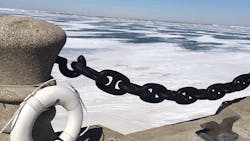I grew up on the shores of Lake Erie.
Don't swim too far.
My family watched Fourth of July fireworks from the beach, our blankets haphazardly sprawled on the sand.
The swings I knew overlooked the blue expanse of the Great Lake, each pump of my legs bringing me ever closer to seeing Canada…this time, for sure.
Don't swing that high.
After leaving for college and then work, I once again live on that same lake. In fact, I can see Lake Erie from my desk (if I angle my body just so).
In the winter, the blue water that defined my childhood freezes over. And, just like the sight of a frozen Niagara Falls brings wonderment to visitors, the icy lake fascinates me.
Don't walk on the ice.
On winter walks during my lunch break, my friends have had to gently remind me, "No, Ginger, you cannot walk on the ice."
My sense of self preservation, of course echoes that. I know it's not safe, but that doesn't stop the pull, the allure of the frozen lake. Not completely.
And I'm not alone.
Just a few weeks ago, I read of a man in Michigan who tried to walk to Canada across the frozen Lake St. Clair. Thankfully, before hypothermia could fully settle in, he was rescued by the U.S. Coast Guard.
It was the first Great Lakes rescue of an individual by an ice cutter in four years, reports said.
I don't know his motive, but I understand the draw.
There's a scene in Dr. Who (that British sci-fi TV series) in which the protagonist the Doctor, when faced with a seemingly bottomless chasm, chooses the free fall.
DOCTOR: Hmm, there it is again. That itch. Go down, go down, go down, go down, go down.
IDA: The urge to jump. Do you know where it comes from, that sensation? Genetic heritage. Ever since we were primates in the trees. It's our body's way of testing us. Calculating whether or not we can reach the next branch.
DOCTOR: No, that's not it. That's too kind. It's not the urge to jump. It's deeper than that. It's the urge to fall!
It's not about getting some thrill out of not wearing a hard hat or leaning a little too far on a ladder. It's not about trying to calculate, to gauge our ability.
It's about the urge to fall.
Sometimes, we don't do the smart thing, the sensible thing. Sometimes, we want to reach just a little bit farther. We want to redefine limits. Sometimes, we want to be invincible.
We want to let go and see what happens. We want to fall.
How do you protect against that?
I think it's about that voice in your head, the one telling me not to walk on ice, the voice fine-tuned by years of guidance. It's nurture staring down nature.
In the workplace, it's about culture.
It's about taking the intangible, the nonsensical and safeguarding against it.
It's about developing that safety mindset, so that even when faced with the urge to fall, we choose to stay behind the railing. It's making safety – on and off the job – so ingrained in our thought processes, that that voice will always speak up when confronting the urge.
Send an e-mail with your thoughts to [email protected].
About the Author
Ginger Christ
Associate Editor
Ginger Christ is an associate editor for EHS Today, a Penton publication.
She has covered business news for the past seven years, working at daily and weekly newspapers and magazines in Ohio, including the Dayton Business Journal and Crain’s Cleveland Business.
Most recently, she covered transportation and leadership for IndustryWeek, a sister publication to EHS Today.
She holds a bachelor of arts in English and in Film Studies from the University of Pittsburgh.

